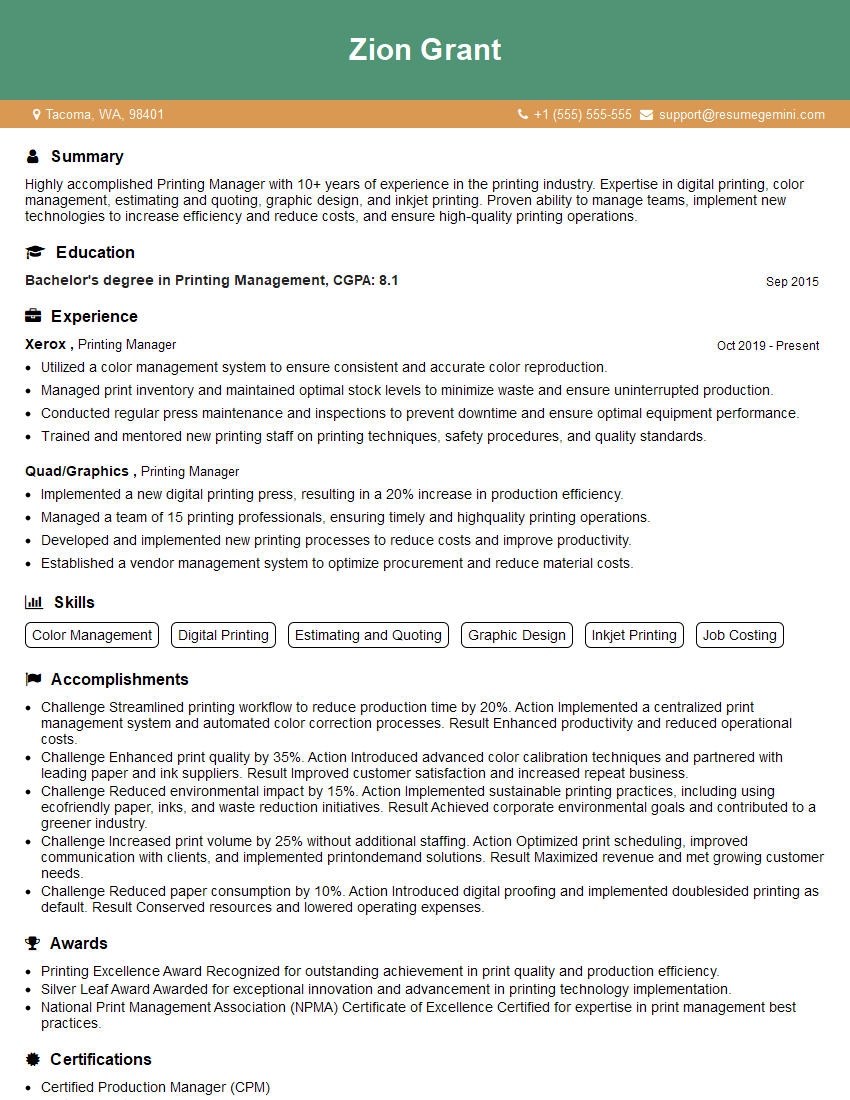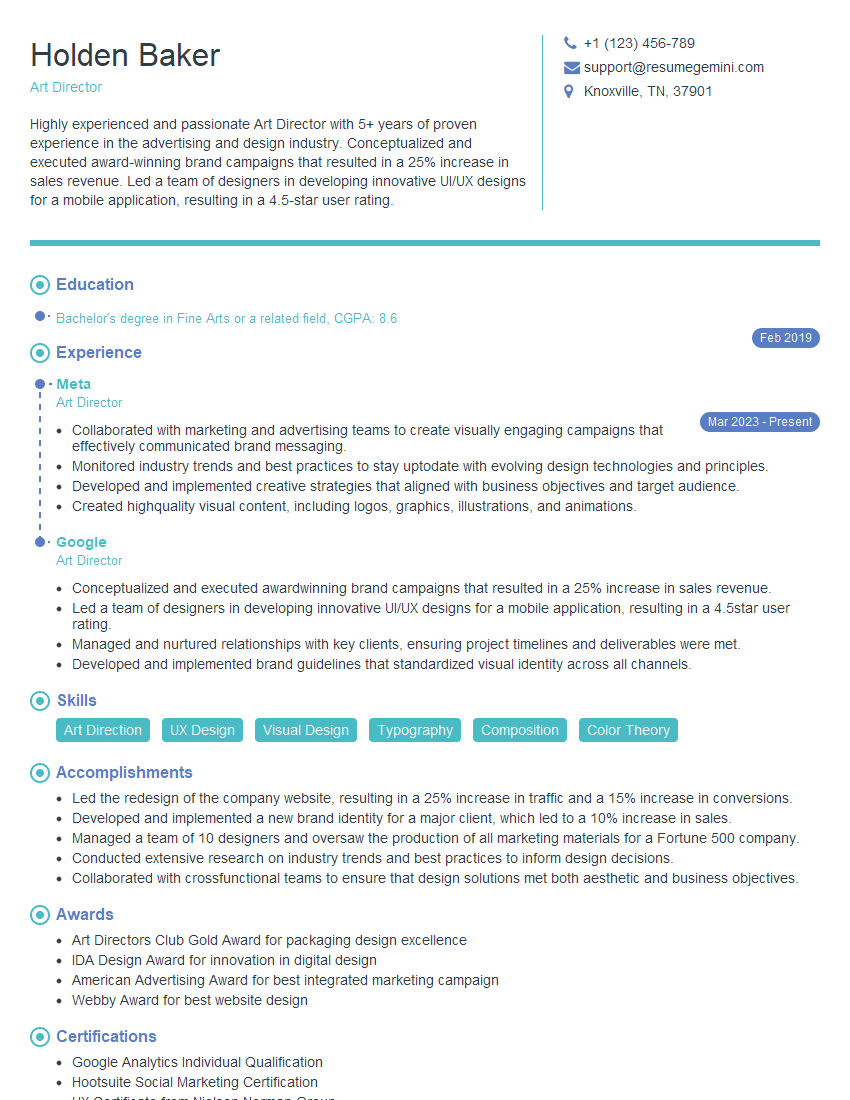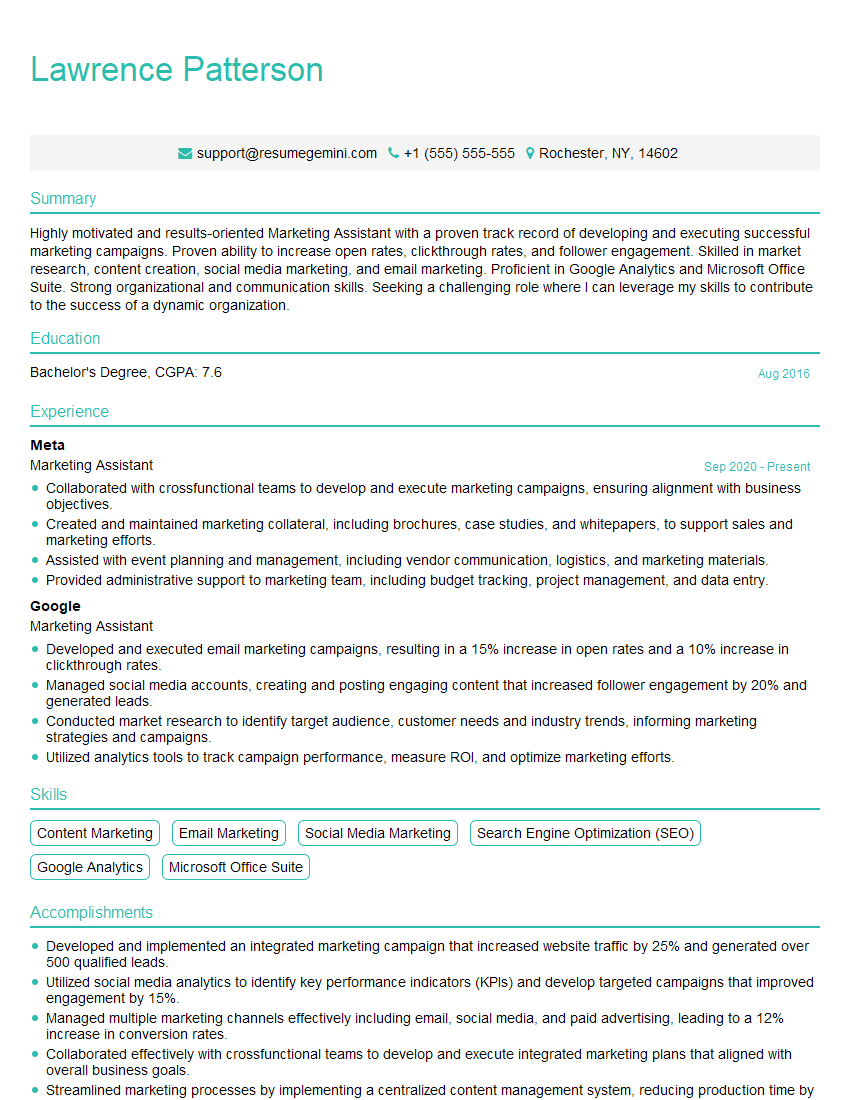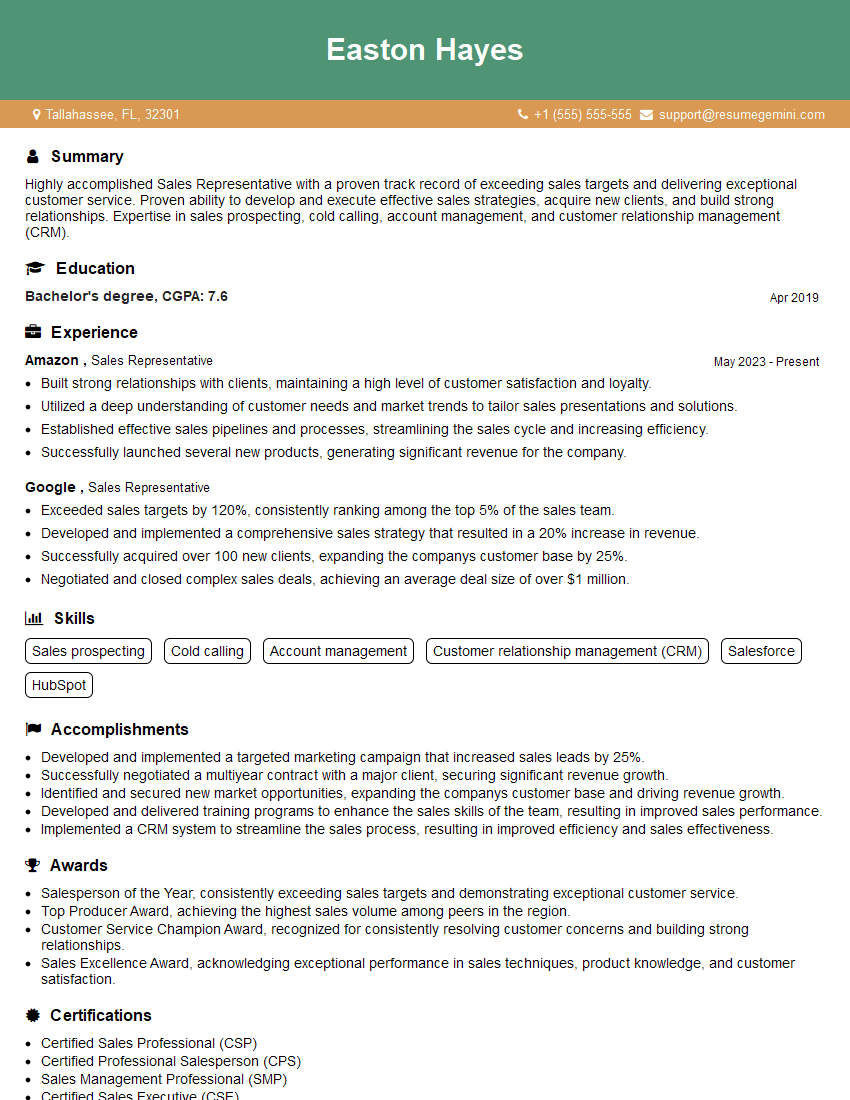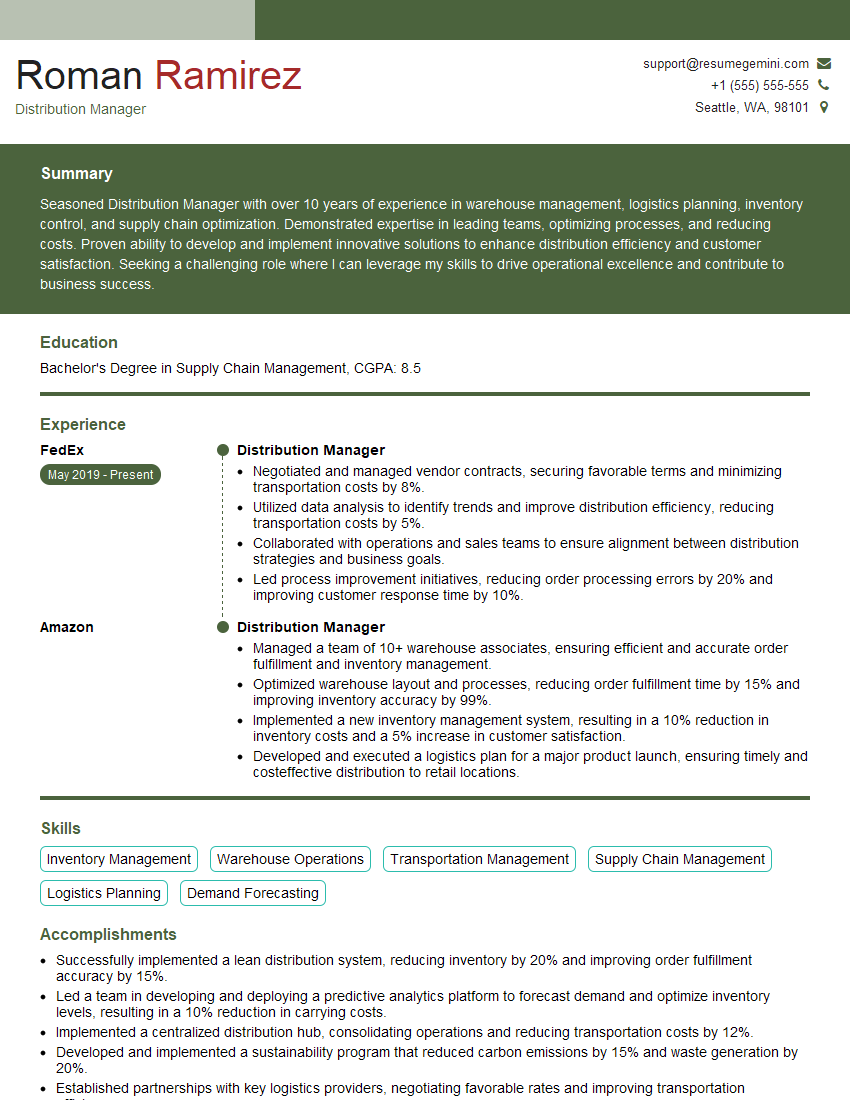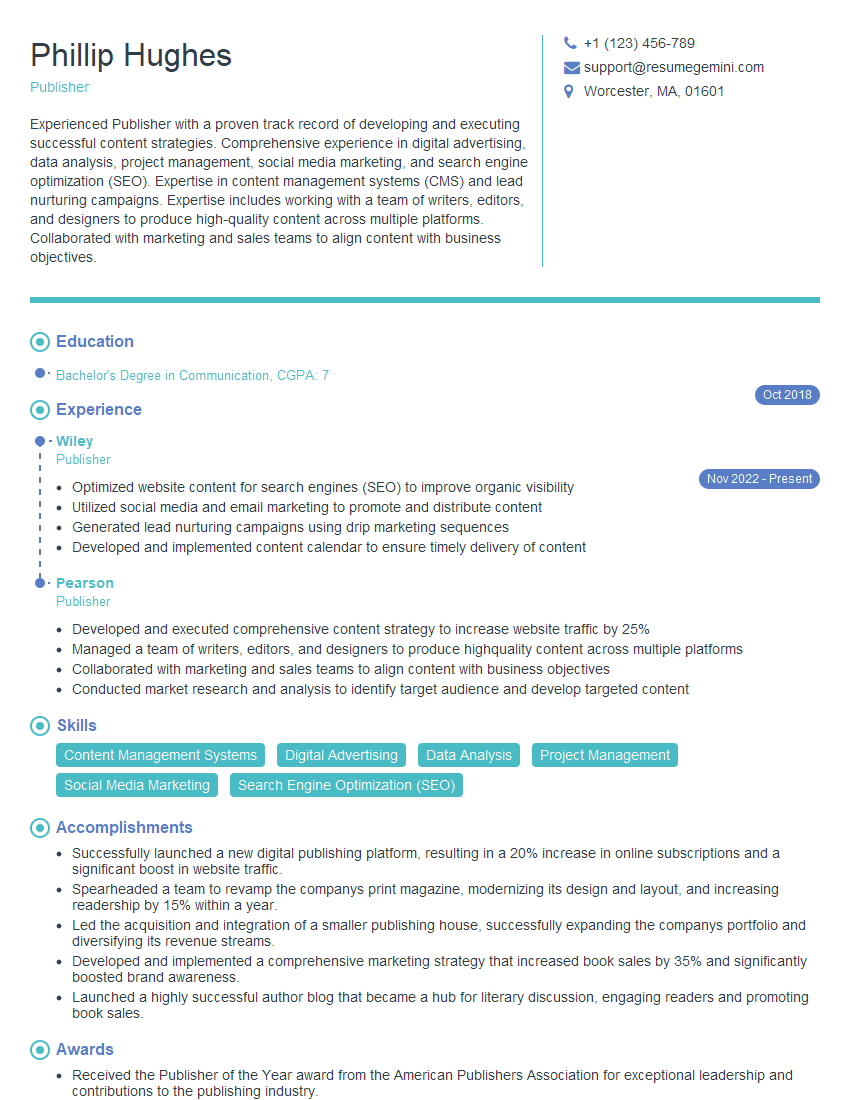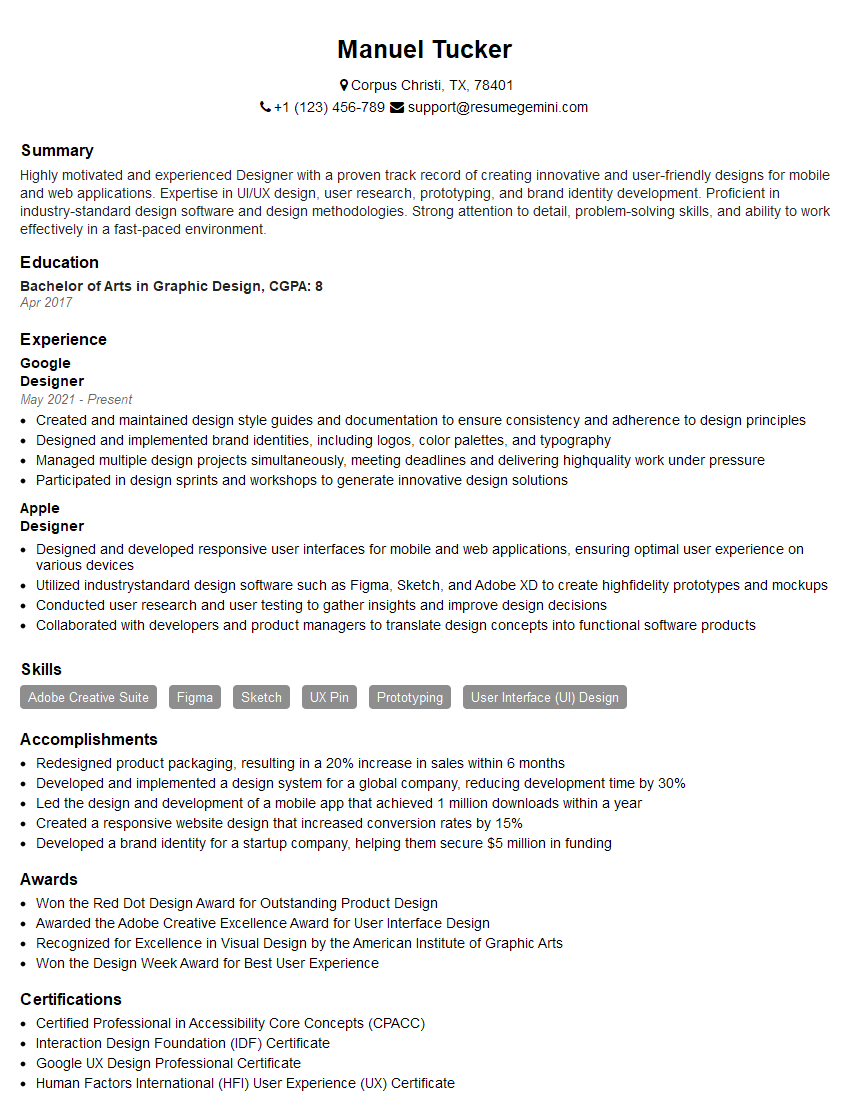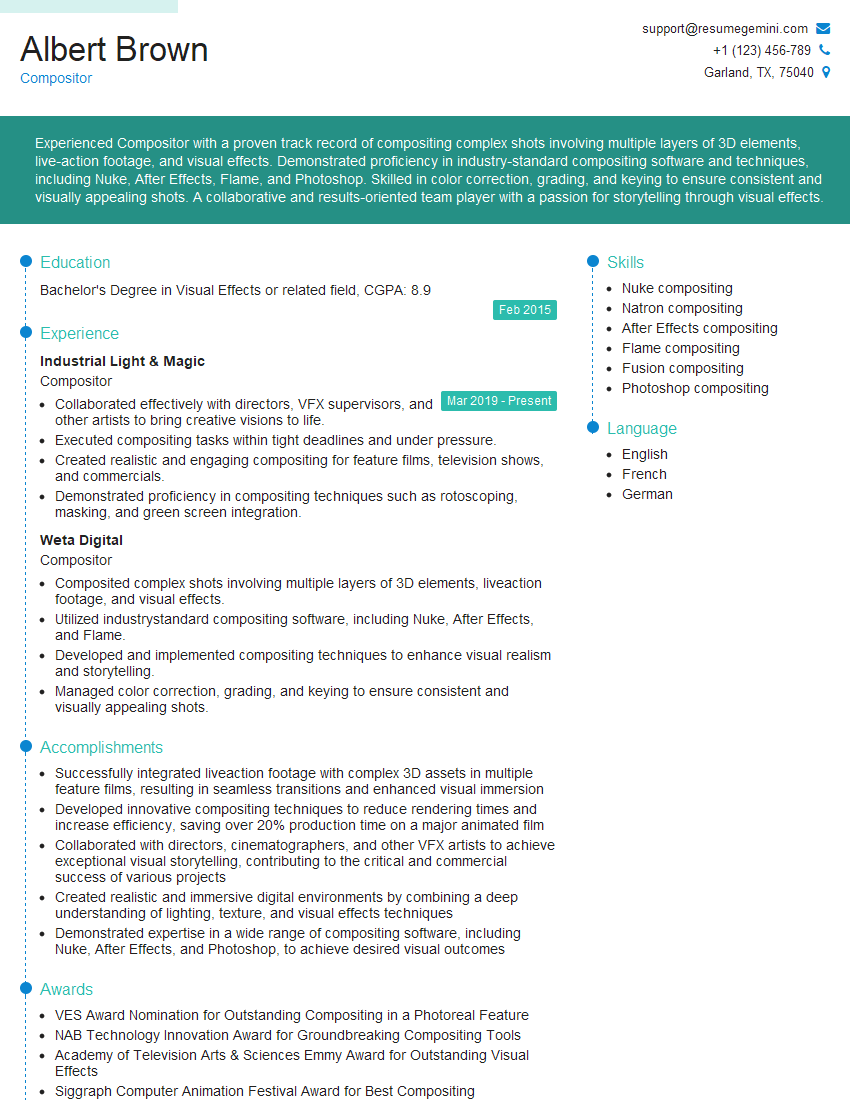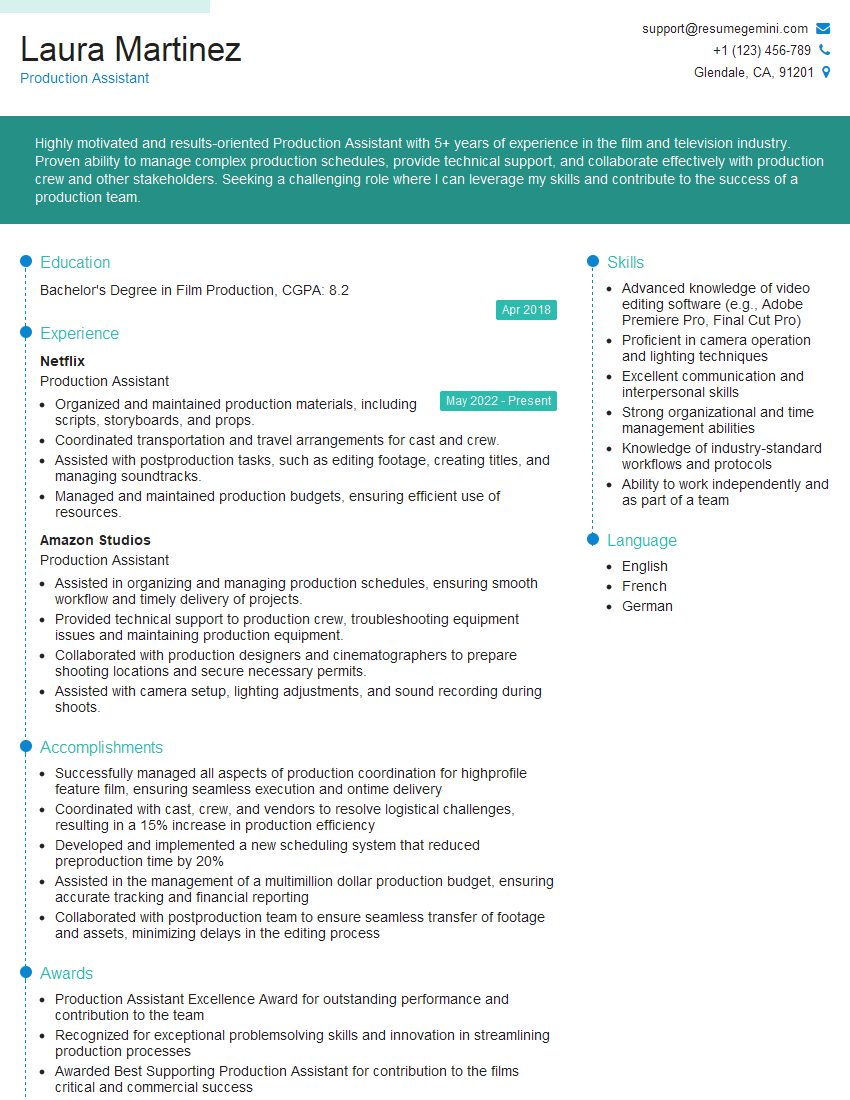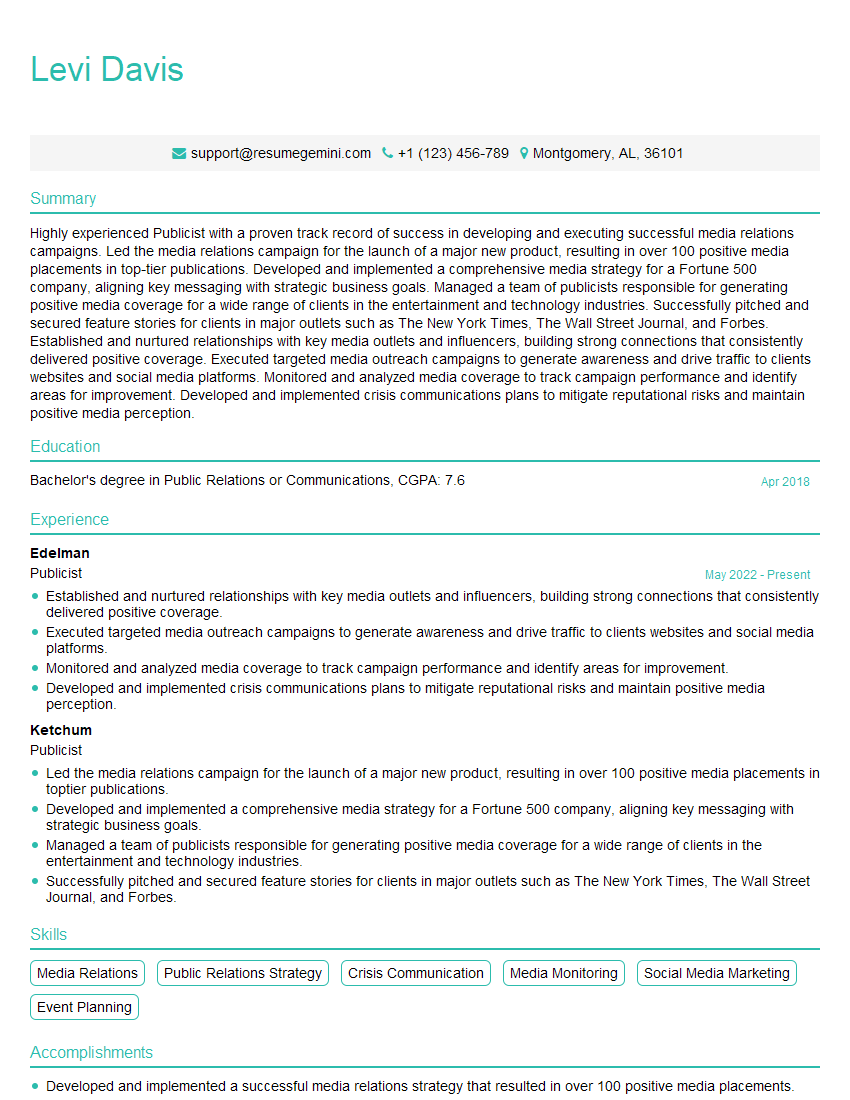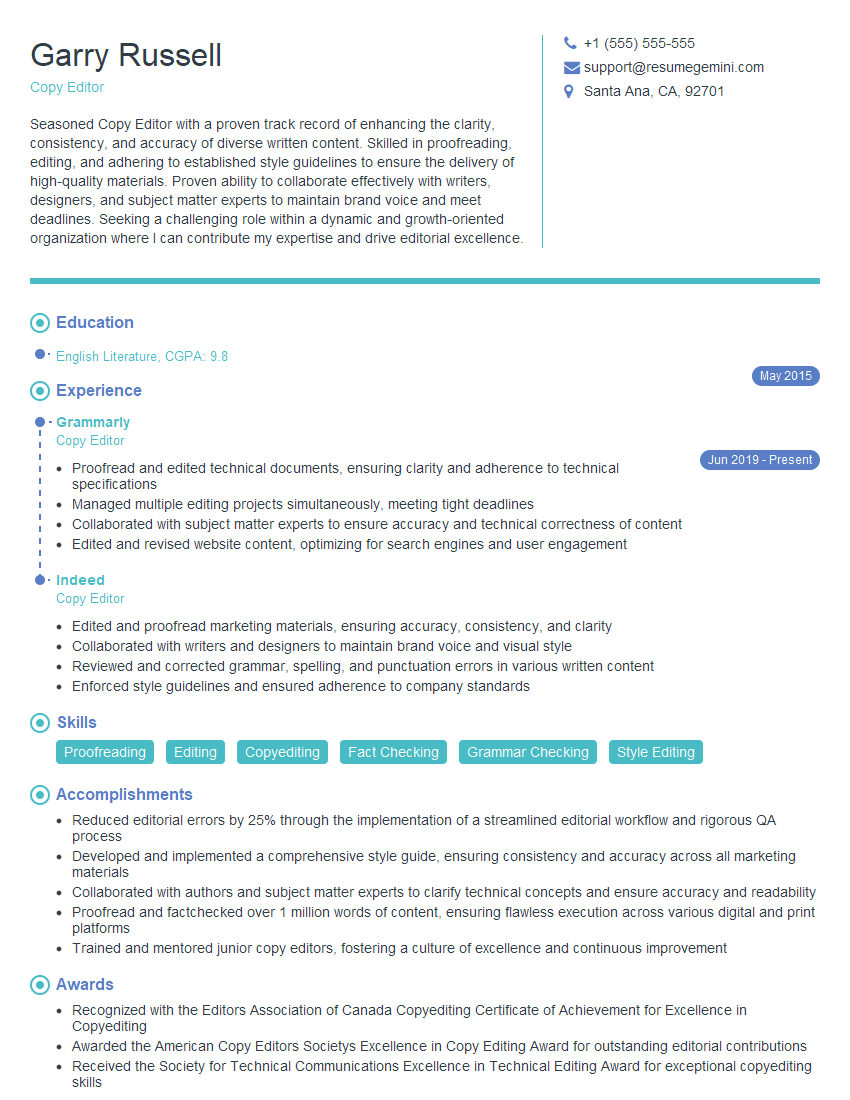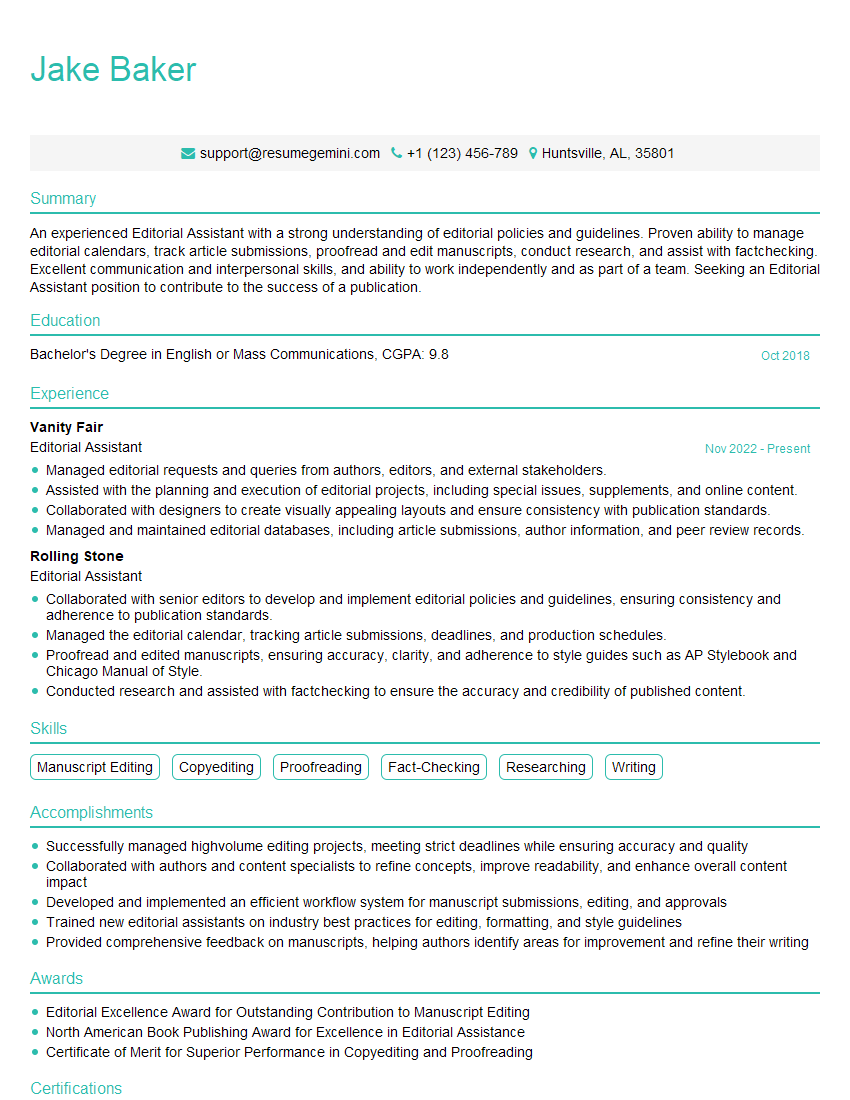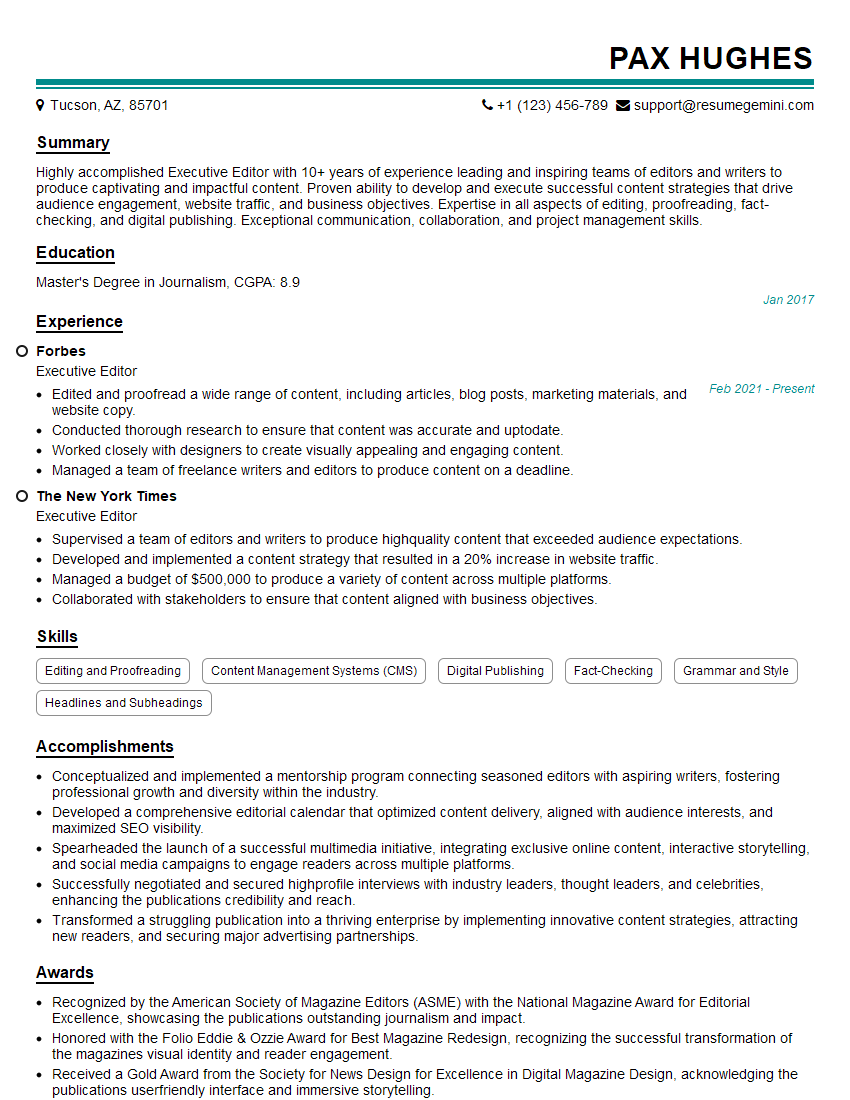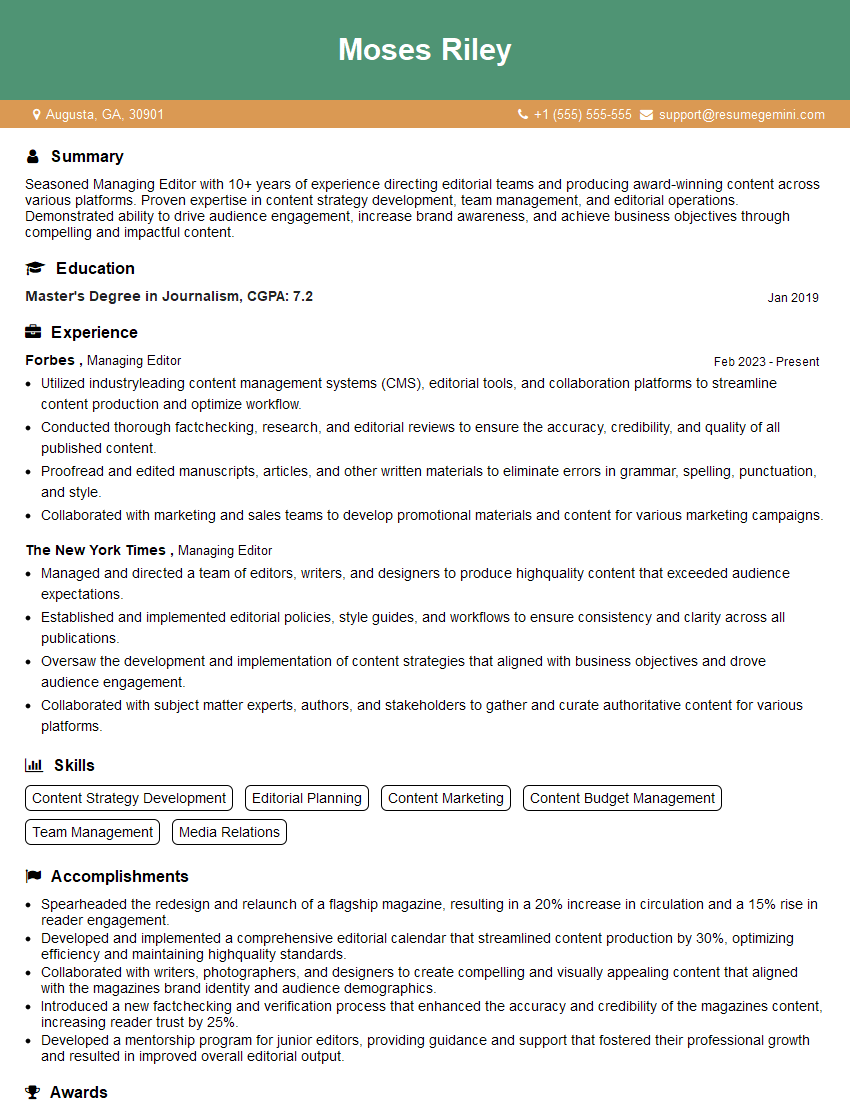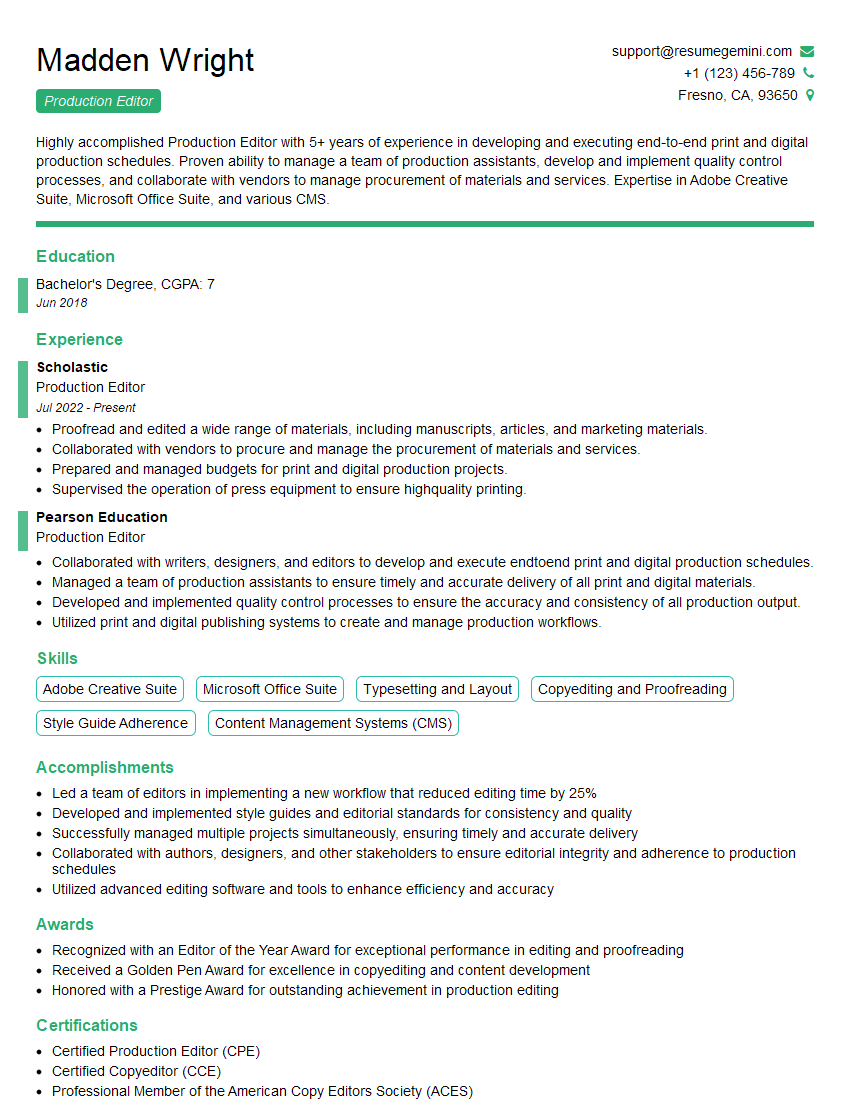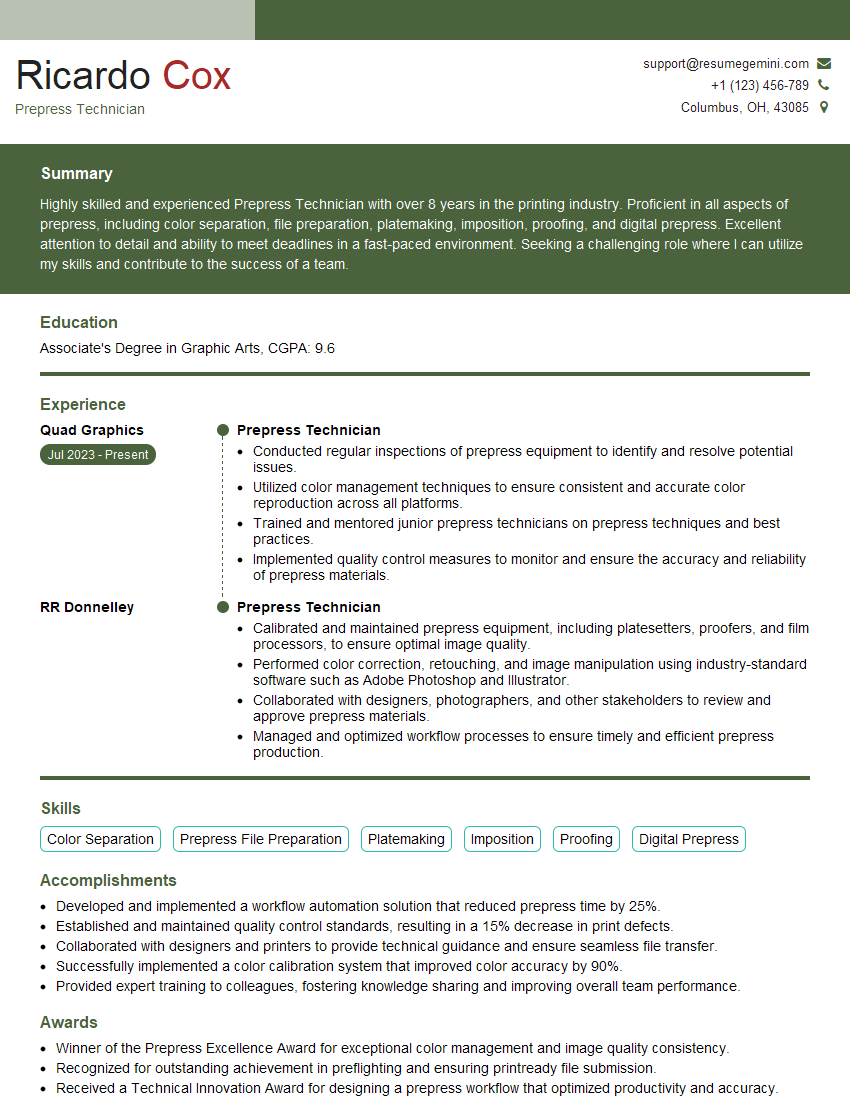Cracking a skill-specific interview, like one for Book Publishing, requires understanding the nuances of the role. In this blog, we present the questions you’re most likely to encounter, along with insights into how to answer them effectively. Let’s ensure you’re ready to make a strong impression.
Questions Asked in Book Publishing Interview
Q 1. Explain the different stages of book production.
Book production is a multi-stage process, akin to building a house – each step is crucial for a final, structurally sound product. It begins with Manuscript Acquisition where publishers acquire manuscripts through agents or direct submissions. Next comes Manuscript Editing, involving developmental editing (big-picture structural changes), copyediting (grammar, style, fact-checking), and proofreading (final error check). Simultaneously, Design and Layout commences, where the book’s visual elements are created, including cover design, typography, and interior layout. Typesetting converts the edited manuscript into a print-ready file, often using software like InDesign. Then, Pre-press Production involves preparing files for printing, including checking color accuracy and ensuring print-quality. Printing and Binding are next, depending on the chosen format (hardcover, paperback, etc.). Finally, Distribution and Marketing put the finished product in the hands of readers through various channels.
- Example: For a historical fiction novel, developmental editing might involve restructuring chapters for improved pacing, while copyediting would correct grammatical errors and ensure historical accuracy.
Q 2. Describe your experience with manuscript evaluation and assessment.
My experience in manuscript evaluation emphasizes a holistic approach. I assess not only the writing quality – grammar, style, narrative voice – but also the marketability, considering genre trends, target audience, and competition. I look for a compelling story, well-developed characters, and a strong plot structure. A crucial aspect is identifying the manuscript’s strengths and weaknesses, providing constructive feedback to authors, ultimately guiding them toward the strongest possible version. I’ve worked with manuscripts ranging from literary fiction and thrillers to non-fiction biographies and self-help guides, adapting my assessment criteria to the specific genre and expectations.
- Example: In evaluating a romance novel, I would look at the chemistry between characters, the pacing of the relationship development, and the overall emotional arc of the story, in addition to the standard editing considerations.
Q 3. What are your preferred methods for copyediting and proofreading?
My copyediting and proofreading methods are meticulous and systematic. For copyediting, I utilize style guides like the Chicago Manual of Style or AP Stylebook, depending on the project’s requirements. I employ a combination of manual review and software tools like Grammarly or ProWritingAid for enhanced accuracy. Proofreading involves a careful final read, often with a printed copy, to catch any remaining errors that might have slipped through previous stages. I always maintain a detailed record of edits and changes, ensuring transparency and clarity for the author.
- Example: When copyediting, I pay close attention to consistency in character names, locations, and timeline. In proofreading, I specifically look for typographical errors, inconsistencies in formatting, and errors in pagination.
Q 4. How do you manage competing deadlines and priorities in a fast-paced environment?
Managing competing deadlines and priorities in publishing requires a robust organizational system. I use project management tools, prioritizing tasks based on urgency and importance, employing techniques like time blocking and agile methodologies. Open communication with authors, designers, and other stakeholders is essential. Clearly defined roles and responsibilities prevent overlaps and confusion. Regular progress reviews help identify potential delays early on, allowing for proactive adjustments to maintain the project’s timeline. Flexibility is key – sometimes, re-prioritizing tasks becomes necessary depending on unforeseen circumstances.
- Example: I might use a Gantt chart to visualize deadlines and dependencies between different stages of the production process, allowing for better tracking and anticipation of potential delays.
Q 5. Outline your experience with working with authors.
My experience working with authors is built on collaboration and mutual respect. I view authors as partners in the publishing process. I believe open communication is crucial, fostering a transparent and trusting relationship. I provide constructive feedback in a sensitive yet direct manner, explaining my rationale for suggested changes. I aim to empower authors, helping them understand the publishing process and guiding them towards realizing their creative vision. I’ve worked with both established authors and debut novelists, adapting my approach to suit each individual’s needs and experience level.
- Example: I’ve helped debut novelists navigate the complexities of the publishing world, from understanding contracts to marketing their books, acting as a mentor in addition to an editor.
Q 6. Describe your familiarity with different book formats (e.g., ebook, paperback, hardcover).
My familiarity with different book formats is extensive. I understand the technical specifications of each, including ebook formats (EPUB, MOBI, PDF), paperback (trade paperback, mass-market paperback), and hardcover (casebound, dust jacket). Each format presents its own unique challenges and considerations regarding design, layout, and file preparation. For ebooks, responsiveness and accessibility are critical. Paperbacks require attention to paper stock, printing methods, and binding. Hardcovers demand higher-quality materials and more intricate binding processes. I am adept at working with designers and printers to ensure the final product meets the highest quality standards, regardless of the format.
- Example: Designing an ebook requires ensuring the text reflows properly on different screen sizes, while a hardcover edition needs careful consideration of the cover board and its durability.
Q 7. How do you ensure consistent brand messaging across all marketing materials?
Ensuring consistent brand messaging across all marketing materials is vital for building brand recognition and reader loyalty. This involves developing a comprehensive brand style guide, outlining key elements like logo usage, typography, color palettes, and tone of voice. All marketing materials, from website copy to social media posts to print advertisements, should adhere to these guidelines. A centralized content repository helps maintain consistency and prevents contradictory messaging. Regular reviews and updates of the brand guidelines ensure they remain relevant and reflect the evolving brand identity.
- Example: If a book series features a consistent color scheme, that same scheme should be replicated across all marketing materials, including book covers, website banners, and social media graphics.
Q 8. Explain your approach to budgeting and cost control in book publishing.
Budgeting and cost control in book publishing is a delicate balancing act between creative vision and financial viability. It requires meticulous planning from the initial manuscript acquisition to final distribution. My approach involves a multi-stage process:
- Pre-Publication Budgeting: This involves estimating costs for manuscript acquisition (advances, royalties), editing (copyediting, proofreading, developmental editing), design and typesetting, cover art creation, printing (depending on print run and chosen printer), marketing and publicity, and distribution.
- Contingency Planning: I always build in a contingency buffer (typically 10-15%) to account for unforeseen expenses, such as reprint costs or unexpected delays.
- Regular Monitoring and Reporting: Throughout the process, I regularly track expenses against the budget, generating reports to identify potential overruns and take corrective action. This usually involves using project management software.
- Cost Optimization Strategies: This includes exploring different printing options, negotiating favorable terms with vendors, utilizing cost-effective marketing channels, and prioritizing essential tasks.
- Post-Publication Analysis: After the book’s release, a thorough analysis of actual costs versus the initial budget helps refine future budgeting practices and identify areas for improvement.
For example, for a mid-list fiction novel, I’d allocate a significant portion of the budget to marketing and publicity, recognizing its importance in reaching a wider audience. For a niche non-fiction title, I might allocate more resources to targeted marketing efforts.
Q 9. What is your experience with ISBN and copyright registration?
ISBNs (International Standard Book Numbers) and copyright registration are crucial for identifying and protecting a book. My experience encompasses the entire process:
- ISBN Acquisition: I’m proficient in obtaining ISBNs from the appropriate agency for each country of publication. This involves understanding the various ISBN prefix assignments and ensuring accuracy in the application process. The ISBN is essential for book distribution and sales tracking.
- Copyright Registration: I advise authors on copyright protection, guiding them through the process of registering their work with the relevant copyright office (e.g., the U.S. Copyright Office). This legal protection safeguards the author’s rights and prevents unauthorized use of their intellectual property. It’s vital to understand the implications of different copyright licenses and to document all aspects thoroughly.
- Copyright Agreements: I draft and review copyright agreements, ensuring the rights of both the author and the publisher are clearly defined and protected. I make sure that all potential disputes are addressed preemptively.
In one instance, I helped an author secure an ISBN and register their copyright before submitting their manuscript to agents. This demonstrated professionalism and protected their work, enhancing their credibility during the publication process.
Q 10. Describe your understanding of book marketing strategies (e.g., social media, advertising).
Book marketing strategies are dynamic and depend heavily on the genre, target audience, and budget. My approach is multi-faceted and includes:
- Social Media Marketing: I leverage various platforms like Facebook, Instagram, Twitter, and TikTok to create engaging content, run targeted ads, and build a community around the book. This includes tracking analytics to ensure campaigns are effective and making adjustments as needed.
- Traditional Advertising: I explore advertising opportunities in relevant publications, both print and online, to reach specific demographics. This often involves negotiating advertising rates and monitoring campaign performance.
- Public Relations (PR): I collaborate with publicists to secure media coverage through book reviews, interviews, and appearances at book festivals and conferences. Building relationships with key influencers and media outlets is a key component of this.
- Email Marketing: I utilize email newsletters to cultivate relationships with readers and provide updates on the book. I segment readers based on interests to tailor my marketing messages for optimal engagement.
- Influencer Marketing: Identifying and working with relevant influencers (book bloggers, reviewers, etc.) on social media to create awareness and build anticipation for the book’s release.
For example, for a young adult fantasy novel, I might focus heavily on TikTok and Instagram, while for a scholarly work, I might prioritize academic journals and targeted email marketing.
Q 11. How do you measure the success of a book launch?
Measuring the success of a book launch isn’t solely about sales figures, though those are important. A holistic approach is crucial, considering:
- Sales Figures: Tracking initial sales figures provides a clear indication of the book’s market reception. I analyze sales data across various channels (online retailers, bookstores).
- Reviews and Ratings: Positive reviews on platforms like Goodreads, Amazon, and specialized review sites build credibility and influence future sales. I track review scores, both positive and negative, to understand public perception.
- Social Media Engagement: Monitoring social media interactions (likes, shares, comments, mentions) helps assess the book’s reach and audience engagement. Analyzing trends in these metrics helps identify successful content strategies.
- Website Traffic: Analyzing traffic on the author’s website or the publisher’s website provides insights into the level of reader interest and engagement generated through marketing efforts. This is key for gauging the campaign’s effectiveness.
- Media Coverage: I evaluate the amount and type of media coverage received – print, broadcast, and online. This provides an indication of brand awareness and positive sentiment.
A successful launch isn’t just about high sales initially but also about building a sustainable readership and establishing a positive reputation for the author and their book.
Q 12. How do you handle disagreements with authors?
Disagreements with authors are inevitable in the publishing process. My approach emphasizes open communication, collaboration, and mutual respect:
- Open Dialogue: I foster open and honest communication with authors from the outset. This means clearly defining expectations, roles, and responsibilities in the contract.
- Mediation: If disagreements arise, I prioritize finding solutions that satisfy both parties. This may involve mediating discussions, suggesting compromises, and emphasizing the shared goal of creating a successful book.
- Professionalism: I maintain a professional and respectful demeanor at all times, even when faced with challenging situations. Emotions are acknowledged but the focus remains on professional resolution.
- Legal Counsel: In cases of significant or unresolved disputes, I consult with legal counsel to ensure that all actions are legally sound and protect the publisher’s interests.
- Documentation: I keep meticulous records of all communication and decisions made, protecting both myself and the author from potential misunderstandings and disputes.
In one instance, a disagreement arose regarding cover art. Through open discussion and compromise, we managed to find a design that pleased both the author and the publisher without delaying the publication timeline.
Q 13. Describe your experience with working with printers and distributors.
My experience with printers and distributors spans several years and involves various types of projects. I’ve established strong working relationships with trusted vendors:
- Printer Selection: I select printers based on their capabilities, quality, cost-effectiveness, and turnaround times. This includes considerations for print type (offset, digital), paper stock, and binding.
- Negotiation: I negotiate contracts with printers, ensuring favorable pricing and deadlines, and clarifying all terms and conditions.
- Quality Control: I maintain strict quality control procedures, reviewing proofs and ensuring that the final printed book meets the required standards. This often involves approving proofs at several stages.
- Distributor Relationships: I work closely with distributors to ensure efficient and cost-effective distribution of the book through various channels (retailers, libraries, wholesalers).
- Inventory Management: I collaborate with distributors to manage inventory levels, minimizing storage costs and preventing stockouts.
I have a network of reliable printers and distributors, including both large international firms and smaller niche specialists, allowing me to tailor my choice to the specifics of each project.
Q 14. What is your experience with digital rights management (DRM)?
Digital Rights Management (DRM) is a crucial aspect of protecting digital books. My experience includes:
- DRM Implementation: I understand different DRM technologies (e.g., Adobe DRM, watermarking) and their implications. The choice of DRM depends on the specific needs of the publisher and the author, balancing the need for security with user experience.
- Platform Integration: I have experience integrating DRM into various e-book formats and platforms (e.g., Amazon Kindle, Apple Books, Kobo). This necessitates a clear understanding of the technical requirements of each platform.
- User Experience Considerations: I carefully consider the user experience when implementing DRM, ensuring that it does not unduly hinder readers’ access to the book. Finding a balance between security and accessibility is crucial.
- Licensing Agreements: I work with authors to understand and agree on the terms of digital rights licensing, clarifying how DRM will be implemented and the limitations it places on distribution.
- Legal Compliance: I am aware of the legal and ethical implications of using DRM and ensure that all implementations comply with relevant regulations.
For example, for a self-published author, I might recommend a less restrictive DRM solution to maximize their reach and sales.
Q 15. How do you stay current with trends in the book publishing industry?
Staying current in the dynamic book publishing industry requires a multi-pronged approach. It’s not just about reading the latest industry news; it’s about actively participating and analyzing the landscape.
- Industry Publications and Websites: I regularly read publications like Publishers Weekly, The Bookseller, and follow relevant blogs and websites that offer insights into publishing trends, new technologies, and market analysis. This gives me a broad overview of the industry’s pulse.
- Conferences and Workshops: Attending industry conferences like BookExpo America or Frankfurt Book Fair allows me to network with other professionals, learn about emerging trends firsthand, and gain a deeper understanding of current best practices. The discussions and presentations at these events are invaluable.
- Data Analysis: I closely monitor sales data, bestseller lists, and reader reviews to identify emerging trends in genres, topics, and author styles. This data-driven approach helps me understand what resonates with readers and anticipate future trends.
- Social Media and Online Communities: Participating in relevant online communities and following key influencers on platforms like Twitter and LinkedIn keeps me abreast of the latest discussions, news, and innovations within the publishing world. This allows me to gain diverse perspectives.
- Competitor Analysis: Regularly analyzing the strategies and successes of competitor publishers helps me identify effective approaches and understand market saturation in specific genres.
This combination of active engagement and data-driven analysis provides a holistic view of the industry, ensuring I remain at the forefront of current trends and best practices.
Career Expert Tips:
- Ace those interviews! Prepare effectively by reviewing the Top 50 Most Common Interview Questions on ResumeGemini.
- Navigate your job search with confidence! Explore a wide range of Career Tips on ResumeGemini. Learn about common challenges and recommendations to overcome them.
- Craft the perfect resume! Master the Art of Resume Writing with ResumeGemini’s guide. Showcase your unique qualifications and achievements effectively.
- Don’t miss out on holiday savings! Build your dream resume with ResumeGemini’s ATS optimized templates.
Q 16. How familiar are you with different publishing contracts?
My familiarity with publishing contracts is extensive. I’ve worked with various contract types, from traditional publishing agreements to hybrid and self-publishing contracts. Understanding the nuances of each is critical for both authors and publishers.
- Traditional Publishing Contracts: These are the most common and usually involve a publisher acquiring all rights to the manuscript in exchange for an advance and royalties. Key clauses to understand include copyright assignment, advance payment terms, royalty rates, publication timeline, and termination clauses. I’m experienced in negotiating these clauses to achieve favorable terms for both parties.
- Subsidy Publishing Contracts: These contracts require the author to pay a fee for the publishing services, often in exchange for higher royalty rates or greater control. It’s crucial to carefully evaluate the financial implications and transparency of such contracts.
- Hybrid Publishing Contracts: These contracts blend aspects of traditional and self-publishing, often involving shared responsibilities between the author and publisher. Understanding the division of costs and responsibilities is vital for these arrangements.
- Self-Publishing Contracts: While technically not a ‘contract’ with a third-party publisher, managing contracts with cover designers, editors, and other service providers is crucial. These agreements need to be carefully drafted to prevent disputes and ensure clear ownership and usage rights.
I always advise authors to seek legal counsel when reviewing any publishing contract to ensure a clear and thorough understanding of their rights and responsibilities.
Q 17. Describe your experience with metadata creation for ebooks.
Creating accurate and comprehensive metadata is essential for ebook discoverability and sales. I have extensive experience in this area, ensuring that each ebook is properly tagged and optimized for search engines and online bookstores.
My process typically includes:
- Keyword Research: Identifying relevant keywords and phrases based on the book’s genre, topic, and target audience. Tools like Google Keyword Planner and Amazon Keyword Tool are invaluable for this task.
- Structured Metadata Creation: Using industry-standard metadata schemas like ONIX and Dublin Core to accurately tag the ebook with information such as title, author, ISBN, publisher, genre, description, keywords, and cover image.
- Data Validation: Verifying the accuracy and consistency of the metadata before submission to ensure proper indexing and discoverability. Inconsistent or missing data can severely impact discoverability.
- Platform-Specific Requirements: Understanding the specific metadata requirements of each ebook platform (Amazon Kindle, Apple Books, Kobo, etc.) and tailoring the metadata accordingly. This is crucial for optimal visibility on each platform.
For example, for a fictional novel, I wouldn’t just use broad terms like ‘fiction’. Instead, I would use more specific keywords like ‘fantasy romance,’ ‘paranormal thriller,’ or even ‘enemies-to-lovers romance’ depending on the novel’s content to reach a more targeted audience.
Q 18. What is your experience with book cover design?
While I don’t design book covers myself, I have a strong understanding of the process and collaborate closely with designers to ensure the final product effectively represents the book’s content and target audience. A well-designed cover is crucial for attracting readers.
My involvement includes:
- Briefing Designers: Providing designers with a detailed brief outlining the book’s genre, target audience, plot, and tone. This ensures the cover design aligns with the book’s overall aesthetic.
- Reviewing Design Concepts: Evaluating multiple design concepts to ensure they are visually appealing, relevant, and accurately reflect the book’s content. This involves considering typography, imagery, and overall composition.
- Providing Feedback: Offering constructive feedback to designers based on my knowledge of market trends and best practices in book cover design. This iterative process ensures the final design is optimized for maximum impact.
- File Preparation: Overseeing the preparation of cover files in the appropriate formats and resolutions for different publishing platforms. This ensures compatibility and high-quality display.
I believe a successful book cover is more than just aesthetically pleasing; it’s a powerful marketing tool that needs to accurately capture the essence of the story and resonate with the intended readership.
Q 19. Explain your approach to analyzing sales data and market trends.
Analyzing sales data and market trends is crucial for making informed decisions in publishing. My approach is data-driven and involves several key steps:
- Data Collection: Gathering sales data from various sources, including online bookstores (Amazon, Barnes & Noble, etc.), distributors, and internal sales reports. This data should be comprehensive and cover a sufficient period to identify trends.
- Data Cleaning and Preparation: Cleaning the data to ensure accuracy and consistency. This may involve correcting errors, handling missing values, and transforming the data into a usable format.
- Data Analysis: Using analytical tools and techniques to identify trends and patterns in sales data. This may involve calculating key metrics such as average sales per title, sales by genre, sales by region, and sales over time.
- Market Trend Analysis: Combining sales data analysis with market research to identify broader trends in the industry, such as changes in reader preferences, emerging genres, and competitor activities.
- Predictive Modeling: Utilizing predictive modeling techniques to forecast future sales based on historical data and market trends. This allows for proactive inventory management and marketing planning.
For instance, if sales data reveals a decline in a particular genre, I would investigate the market to understand the reason – is there a saturation of similar titles? Have reader preferences shifted? This allows us to make data-informed decisions about future acquisitions and marketing strategies.
Q 20. Describe your understanding of different genres and their target markets.
A deep understanding of different genres and their target markets is fundamental to successful publishing. Each genre has unique characteristics, reader expectations, and marketing strategies.
My knowledge spans a wide range of genres, including:
- Fiction: Romance, Thriller, Mystery, Science Fiction, Fantasy, Historical Fiction, Literary Fiction, etc. Each subgenre has its specific tropes, themes, and target audience.
- Non-Fiction: Biography, Memoir, Self-Help, Cookbooks, Business, History, etc. These genres cater to diverse interests and needs.
- Young Adult (YA) and Children’s Literature: These require a nuanced understanding of age-appropriate content and the unique interests of different age groups.
For example, a romance novel’s target audience differs significantly from a non-fiction historical account. Understanding these nuances allows for targeted marketing and editorial strategies. A romance novel might be marketed through social media channels frequented by romance readers, while a historical account could be promoted through academic journals or historical societies.
This understanding helps me assess the potential market for a manuscript, identify its target audience, and develop effective marketing strategies.
Q 21. How would you handle a production delay?
Production delays are inevitable in publishing, but effective management is key to minimizing their impact. My approach involves a combination of proactive planning and reactive problem-solving.
Here’s how I’d handle a production delay:
- Identify the Cause: First, I would thoroughly investigate the cause of the delay. Is it due to printing issues, author revisions, editing delays, or other unforeseen circumstances? Identifying the root cause allows for targeted action.
- Assess the Impact: Once the cause is identified, I’d evaluate the potential impact of the delay on the publication schedule, marketing plans, and overall project budget. Transparency with all stakeholders is crucial.
- Develop a Contingency Plan: Depending on the nature and extent of the delay, I would develop a contingency plan. This might involve adjusting the publication schedule, securing alternative resources (like a different printer), or adapting marketing strategies.
- Communicate Proactively: Open and transparent communication is vital. I’d keep all stakeholders (authors, distributors, marketing teams, etc.) informed about the delay, the reasons behind it, and the steps being taken to mitigate its impact.
- Monitor Progress: Once a solution is implemented, I’d closely monitor progress to ensure the project remains on track. Regular updates and progress reviews help to avoid further complications.
For example, if a printing delay arises, I might explore using a different printer with available capacity, adjust the marketing launch date, or leverage pre-orders to maintain momentum. The key is to act decisively and efficiently, minimizing disruption to the overall publishing process.
Q 22. Describe your experience using publishing software (e.g., InDesign, QuarkXPress).
My experience with publishing software centers primarily around Adobe InDesign, though I’ve also worked with QuarkXPress in the past. InDesign is my preferred tool due to its robust features, particularly its superior handling of complex layouts and long documents. I’m proficient in all aspects of InDesign, from creating master pages and styles to managing images and generating PDFs for print and ebook formats. For example, I’ve used InDesign to create intricate layouts for academic textbooks with numerous diagrams, equations, and sidebars, requiring meticulous attention to detail and consistent formatting. My QuarkXPress experience is largely legacy-based, having used it on several projects before its widespread adoption of InDesign. I can confidently transition between the two as needed, understanding the strengths and limitations of each.
Specifically, I’m comfortable with:
- Master page creation and management
- Style creation and application for text and paragraphs
- Image placement and manipulation (including color correction and retouching)
- Table creation and formatting
- Working with different bleed and trim sizes for print production
- Generating high-resolution PDF files for various purposes (print, e-reader, web)
- Creating interactive elements (e.g., hyperlinks, bookmarks) in ebooks.
Q 23. How do you prioritize tasks to meet deadlines?
Prioritizing tasks to meet deadlines involves a structured approach that combines project management techniques with a clear understanding of dependencies. I typically employ a combination of methods:
- Creating a detailed project schedule: This involves breaking down the project into smaller, manageable tasks and assigning each task a realistic deadline. I utilize Gantt charts or project management software to visualize the timeline and identify potential bottlenecks.
- Prioritizing tasks based on urgency and importance: I use methods like the Eisenhower Matrix (urgent/important) to categorize tasks and prioritize accordingly. Critical path tasks, those that directly impact the overall deadline, receive the highest priority.
- Regularly reviewing progress and adjusting the schedule as needed: I conduct daily or weekly check-ins to monitor progress and address any unexpected delays or roadblocks proactively. This involves communicating with relevant stakeholders and adjusting the schedule accordingly.
- Utilizing time management techniques: I employ methods like the Pomodoro Technique to maintain focus and prevent burnout. Setting realistic goals and taking short breaks helps in maintaining productivity.
For instance, when working on a project with a tight deadline, I would first identify all tasks, their dependencies, and their estimated time requirements. Then, I would prioritize critical tasks like manuscript editing and cover design before moving on to less time-sensitive tasks like indexing. Consistent monitoring and communication are vital to ensure the project stays on track.
Q 24. How familiar are you with different types of printing processes?
My familiarity with printing processes extends across various methods, each with its own strengths and weaknesses. I understand the implications of each process on cost, quality, and turnaround time. Here are some key printing processes I’m knowledgeable about:
- Offset printing: This is the industry standard for large-scale book printing due to its cost-effectiveness for high volumes. I understand the processes involved, including platemaking, inking, and paper handling.
- Digital printing: Ideal for short runs and print-on-demand, digital printing offers speed and flexibility, though it may be more costly for large volumes. I’m aware of the different digital printing technologies available and their respective applications.
- On-demand printing: This method combines digital printing with automated fulfillment, allowing for the printing and shipping of books only when ordered, minimizing storage costs and inventory risk. I’m experienced in working with print-on-demand services like Amazon KDP.
I can advise on selecting the appropriate printing process based on factors such as print run size, budget, paper choice, and quality requirements. The choice between offset and digital printing, for example, depends heavily on the number of copies. Offset printing is more economical for large runs, while digital printing is more suitable for smaller runs or personalized books.
Q 25. Explain your understanding of book distribution channels.
Book distribution channels encompass the various pathways a book takes to reach its readers. My understanding encompasses a range of traditional and modern methods:
- Traditional Wholesale Distribution: This involves partnering with distributors who handle warehousing, shipping, and sales to bookstores and libraries. This channel provides wide reach but often requires significant upfront investment and longer lead times.
- Direct-to-Consumer Sales: Selling books directly to consumers through the publisher’s website or online marketplaces like Amazon offers greater control over pricing and marketing but requires dedicated resources for e-commerce and fulfillment.
- Print-on-Demand: As mentioned, print-on-demand services handle the entire printing and shipping process, eliminating the need for large-scale inventory management. This is particularly beneficial for books with low initial demand or niche titles.
- Online Retailers: Major online retailers like Amazon, Barnes & Noble, and others play a significant role in book distribution, offering considerable reach to a wide consumer base.
- Library Distribution: Supplying books to libraries through specialized library wholesalers is a crucial channel, providing access to a significant readership.
Understanding the strengths and weaknesses of each channel is crucial for maximizing sales and reaching the target audience. A strategic approach often involves a mix of channels, tailored to the book’s genre, target market, and budget.
Q 26. How do you track and manage inventory?
Inventory management in book publishing requires a robust system to track stock levels, monitor sales, and predict future demand. Effective inventory management minimizes costs associated with overstocking or stockouts. My approach typically involves:
- Utilizing inventory management software: Software solutions provide automated tracking of stock levels, sales data, and order fulfillment. This allows for efficient monitoring and forecasting.
- Regular stocktaking: Physical stocktaking is essential for verifying inventory accuracy and identifying discrepancies. This helps to maintain the integrity of the inventory data.
- Forecasting demand: Analyzing sales data and market trends allows for accurate prediction of future demand, enabling optimal stock levels and minimizing waste.
- Implementing a first-in, first-out (FIFO) system: This method ensures that older books are sold first, reducing the risk of obsolescence.
- Establishing reorder points: Setting reorder points triggers automatic orders when stock levels fall below a predetermined threshold, preventing stockouts.
For example, I’ve used inventory management software to track sales data, analyze trends, and forecast demand for various book titles. This data then informs our ordering and printing processes, ensuring we have the right amount of stock available without excessive storage costs.
Q 27. How familiar are you with industry standards for book production?
I’m intimately familiar with industry standards for book production, including:
- ISBNs (International Standard Book Numbers): Understanding the role of ISBNs in book identification and cataloging is fundamental. I know how to obtain ISBNs and their proper implementation.
- BISAC (Bowker Subject Headings): Accurate subject classification is essential for effective book discovery and cataloging. I understand the BISAC system and its importance in metadata.
- Copyright and Permissions: I’m well-versed in copyright law and the procedures for securing necessary permissions for text, images, and other copyrighted material.
- File Formats and Specifications: I’m proficient in working with various file formats used in book production, including PDF, InDesign files (INDD), and various image formats. I understand specifications for print-ready files.
- Print Specifications (Trim Size, Bleeds, etc.): I’m experienced in adhering to precise specifications for printing, ensuring consistency and high-quality results.
Adherence to these standards ensures smooth production, efficient cataloging, and optimal distribution. For instance, ensuring a print-ready PDF complies with the printer’s specifications is crucial to avoiding delays and costly reprints.
Q 28. Describe your experience in developing marketing campaigns for books.
Developing marketing campaigns for books requires a strategic approach that considers the target audience, book genre, and overall marketing objectives. My experience includes:
- Target audience identification: Defining the ideal reader allows for the creation of tailored marketing messages and selecting appropriate channels.
- Marketing channel selection: This includes utilizing a mix of online and offline channels, such as social media marketing, email marketing, paid advertising (e.g., Google Ads, social media ads), book reviews, author events, and collaborations with influencers.
- Content creation: Developing compelling marketing materials, including book descriptions, cover designs, promotional videos, and blog posts, is critical in attracting readers.
- Budget allocation: Developing a realistic budget that aligns with the overall marketing objectives is essential for efficient resource utilization.
- Campaign tracking and analysis: Monitoring key metrics such as website traffic, social media engagement, and sales allows for campaign optimization and informed decision-making.
For example, when marketing a historical fiction novel, I might focus on building an online community on platforms frequented by the target audience, engaging in relevant social media conversations, and utilizing targeted advertising to reach specific demographics. Post-campaign analysis would help us identify which strategies yielded the highest ROI and adjust future campaigns accordingly.
Key Topics to Learn for Book Publishing Interview
- Acquisition & Editorial: Understanding the process of acquiring manuscripts, evaluating their marketability, and working with authors through the editing process. Practical application: Analyzing a sample manuscript and identifying potential strengths and weaknesses.
- Production & Manufacturing: Knowledge of the various stages involved in book production, from design and typesetting to printing and binding. Practical application: Understanding different printing methods and their cost implications.
- Marketing & Sales: Developing and implementing marketing strategies to reach target audiences, including understanding different marketing channels (online, print, etc.). Practical application: Analyzing a book’s marketing plan and suggesting improvements.
- Rights & Contracts: Familiarity with copyright law and the negotiation of contracts with authors, agents, and other stakeholders. Practical application: Identifying key clauses in a publishing contract.
- Digital Publishing & E-books: Understanding the unique challenges and opportunities of publishing in the digital space. Practical application: Analyzing the market for e-books in a specific genre.
- Financial Aspects: Understanding publishing budgets, royalty structures, and profit margins. Practical application: Developing a simple budget for a hypothetical book project.
- Industry Trends & Analysis: Staying up-to-date on current trends and challenges in the publishing industry. Practical application: Discussing the impact of technology on the book publishing industry.
Next Steps
Mastering the intricacies of book publishing opens doors to a rewarding career filled with creativity and intellectual stimulation. It allows you to contribute to the creation and dissemination of impactful stories and knowledge. To significantly boost your job prospects, creating an ATS-friendly resume is crucial. A well-structured resume highlights your skills and experience effectively, ensuring your application gets noticed by recruiters. We strongly recommend using ResumeGemini to build a professional and impactful resume. ResumeGemini provides a user-friendly platform and offers examples of resumes specifically tailored for Book Publishing roles, helping you present yourself in the best possible light.
Explore more articles
Users Rating of Our Blogs
Share Your Experience
We value your feedback! Please rate our content and share your thoughts (optional).
What Readers Say About Our Blog
Interesting Article, I liked the depth of knowledge you’ve shared.
Helpful, thanks for sharing.
Hi, I represent a social media marketing agency and liked your blog
Hi, I represent an SEO company that specialises in getting you AI citations and higher rankings on Google. I’d like to offer you a 100% free SEO audit for your website. Would you be interested?
